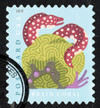
# 5364 - 2019 35c Coral Reefs: Brain Coral
US #5364
2019 Brain Coral – Coral Reefs (Sheet Stamp)
• One of four stamp designs picturing different species of coral and aquatic animals that call reefs home
Stamp Category: Definitive
Set: Coral Reefs
Value: 35¢ Postcard Rate
First Day of Issue: March 29, 2019
First Day City: St. Louis, Missouri
Quantity Issued: 125,000,000
Printed by: Ashton Potter (USA) Ltd.
Printing Method: Offset, Microprint
Format: Panes of 20
Tagging: Nonphosphored Type III, Block Tag
Why the stamp was issued: To cover the postcard rate and celebrate the beauty and diversity of coral reefs.
About the stamp designs: Pictures stylized artwork by Tyler Lang of a spotted moray eel with brain coral.
First Day City: First Day of Issue Ceremony held at the St. Louis Stamp Expo (March 29-31) in St. Louis, Missouri.
About the Coral Reefs set: Four stamps picturing stylized artwork by Tyler Lang of assorted fish with elkhorn, brain, staghorn, and pillar coral. Raises awareness for the plight of coral reef ecosystems across the globe due to climate change and human disturbances.
History the stamp represents: Despite their name, brain coral do not have brains. Their name comes from their appearance, which is strikingly similar to the human organ. While many living closer to the surface are brightly colored, those that grow in deeper waters are grayer, striking an even stronger resemblance.
Found in most of the world’s oceans, brain coral colonies grow six feet or more in height. Most of the brain coral’s body is a hard, rock-like skeletal structure. Only a few millimeters on top of the skeleton grow the soft, living polyp tissue. These coral can live up to 900 years, and when the polyps die, new ones grow on the skeleton, adding to its structure. During the day, the polyps wrap tightly around the skeleton. Then at night, they stretch out to collect food. Brain coral also receive nutrients from the algae that live in their tissues.
Brain coral are very resilient and are a species of least concern. They still face threats such as disease and climate change, but they are well adapted to survive harsher conditions.
There are several varieties of brain coral. Some have stinging tentacles that are used against competing coral to catch food. Some are very colorful and others are fluorescent, making them appear to glow when exposed to UV, violet, or blue light. This makes them a popular addition to saltwater aquariums.
US #5364
2019 Brain Coral – Coral Reefs (Sheet Stamp)
• One of four stamp designs picturing different species of coral and aquatic animals that call reefs home
Stamp Category: Definitive
Set: Coral Reefs
Value: 35¢ Postcard Rate
First Day of Issue: March 29, 2019
First Day City: St. Louis, Missouri
Quantity Issued: 125,000,000
Printed by: Ashton Potter (USA) Ltd.
Printing Method: Offset, Microprint
Format: Panes of 20
Tagging: Nonphosphored Type III, Block Tag
Why the stamp was issued: To cover the postcard rate and celebrate the beauty and diversity of coral reefs.
About the stamp designs: Pictures stylized artwork by Tyler Lang of a spotted moray eel with brain coral.
First Day City: First Day of Issue Ceremony held at the St. Louis Stamp Expo (March 29-31) in St. Louis, Missouri.
About the Coral Reefs set: Four stamps picturing stylized artwork by Tyler Lang of assorted fish with elkhorn, brain, staghorn, and pillar coral. Raises awareness for the plight of coral reef ecosystems across the globe due to climate change and human disturbances.
History the stamp represents: Despite their name, brain coral do not have brains. Their name comes from their appearance, which is strikingly similar to the human organ. While many living closer to the surface are brightly colored, those that grow in deeper waters are grayer, striking an even stronger resemblance.
Found in most of the world’s oceans, brain coral colonies grow six feet or more in height. Most of the brain coral’s body is a hard, rock-like skeletal structure. Only a few millimeters on top of the skeleton grow the soft, living polyp tissue. These coral can live up to 900 years, and when the polyps die, new ones grow on the skeleton, adding to its structure. During the day, the polyps wrap tightly around the skeleton. Then at night, they stretch out to collect food. Brain coral also receive nutrients from the algae that live in their tissues.
Brain coral are very resilient and are a species of least concern. They still face threats such as disease and climate change, but they are well adapted to survive harsher conditions.
There are several varieties of brain coral. Some have stinging tentacles that are used against competing coral to catch food. Some are very colorful and others are fluorescent, making them appear to glow when exposed to UV, violet, or blue light. This makes them a popular addition to saltwater aquariums.







